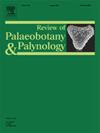Terrestrial end-Guadalupian crisis constrained by mid-latitude Permian palynological data from Jimsar, Junggar Basin, China
IF 1.7
3区 地球科学
Q2 PALEONTOLOGY
引用次数: 0
Abstract
The end-Permian mass extinction and the end-Guadalupian crisis are the most remarkable events in the Permian terrestrial ecosystem. To better understand the end-Guadalupian event in mid-latitude of Pangea in the Northern Hemisphere, palynological investigations are conducted on the terrestrial Permian deposits in the Dalongkou profile of Jimsar, northern Xinjiang, China. Two palynological assemblages are recognized in stratigraphic ascending order, the Cordaitina subrotata–Striatoabieites lipidus–Protowelwitschiapollis exolescus assemblage from the uppermost Lucaogou, Hongyanchi and the lower Quanzijie formations, and the Kraeuselisporites spinulosus–Tuberculatosporites homotubercularis–Potonieisporites turpanensis assemblage from the upper Quanzijie and lowermost Wutonggou formations. Based on the palynological data, the uppermost Lucaogou and Hongyanchi formations are assigned to the Roadian stage, and the lower Quanzijie Formation to the Capitanian stage, and the upper Quanzijie and lowermost Wutonggou formations to the Wuchiapingian stage. Thus, a Wordian-age hiatus is confirmed between the lower Quanzijie Formation and the Hongyanchi Formation on the basis of palynological evidence. The palynofloral succession shows a smooth transition between the Guadalupian and Lopingian palynofloras in the Dalongkou profile of Jimsar, in the Junggar Basin. The end-Guadalupian crisis resulted in a 17% loss of pollen species, indicating that the extinction was on the background level.
准噶尔盆地吉木萨尔中纬度二叠纪孢粉资料约束的瓜达鲁普末期陆相危机
二叠纪末的大灭绝和瓜达鲁普期末的危机是二叠纪陆地生态系统中最显著的事件。为了更好地了解北半球盘古大陆中纬度的瓜德鲁普末期事件,对新疆北部吉木萨尔大龙口剖面的陆相二叠系沉积物进行了孢粉学研究。从地层升序上可识别出两个孢粉组合,即最上层芦草沟组、红盐池组和最下层泉子沟组的Cordaitina subrotata-Striatoabieites lipidus-Protowelwitschiapollis exolescus组合,以及最上层泉子沟组和最下层梧桐沟组的Kraeuselisporites spinulosus-Tuberculatosporites homotubercularis-Potonieisporites turpanensis组合。根据孢粉资料,将芦草沟组上部和红盐池组划分为路甸期,将泉子街组下部划分为capitian期,将泉子街组上部和梧桐沟组下部划分为五家坪期。因此,根据孢粉学证据,确定了全子街组下段与红盐池组之间存在一个世界间隙。准噶尔盆地吉木萨尔大龙口剖面的孢粉区系在瓜达鲁普系和洛平系之间有一个平稳的过渡。瓜达鲁普末期的危机导致17%的花粉物种损失,表明灭绝是在背景水平上。
本文章由计算机程序翻译,如有差异,请以英文原文为准。
求助全文
约1分钟内获得全文
求助全文
来源期刊
CiteScore
3.50
自引率
21.10%
发文量
149
审稿时长
6 months
期刊介绍:
The Review of Palaeobotany and Palynology is an international journal for articles in all fields of palaeobotany and palynology dealing with all groups, ranging from marine palynomorphs to higher land plants. Original contributions and comprehensive review papers should appeal to an international audience. Typical topics include but are not restricted to systematics, evolution, palaeobiology, palaeoecology, biostratigraphy, biochronology, palaeoclimatology, paleogeography, taphonomy, palaeoenvironmental reconstructions, vegetation history, and practical applications of palaeobotany and palynology, e.g. in coal and petroleum geology and archaeology. The journal especially encourages the publication of articles in which palaeobotany and palynology are applied for solving fundamental geological and biological problems as well as innovative and interdisciplinary approaches.

 求助内容:
求助内容: 应助结果提醒方式:
应助结果提醒方式:


